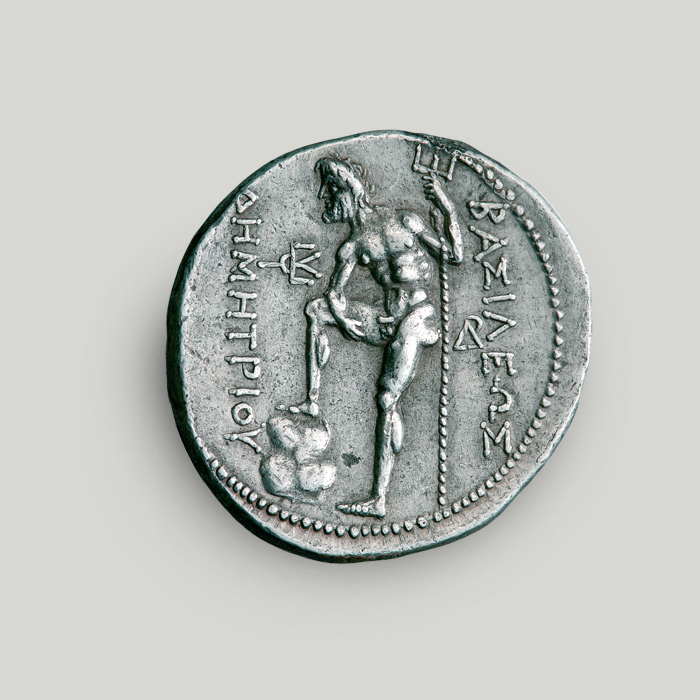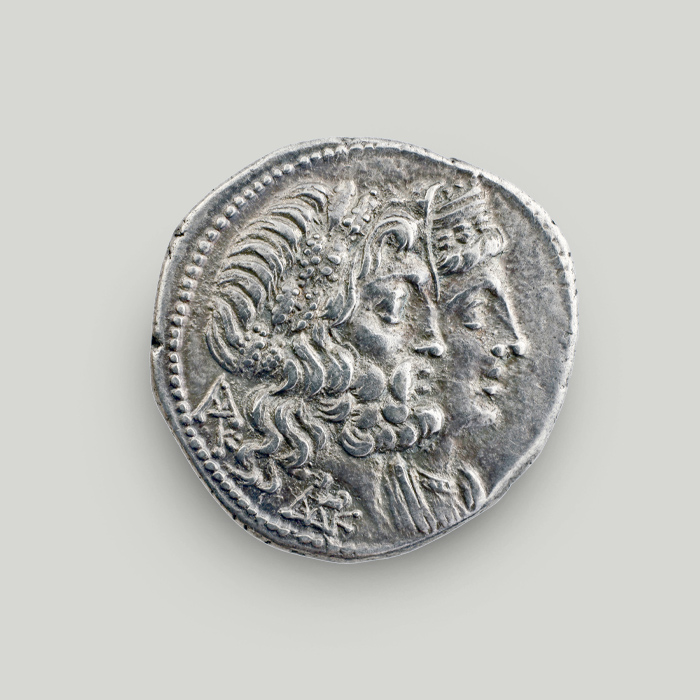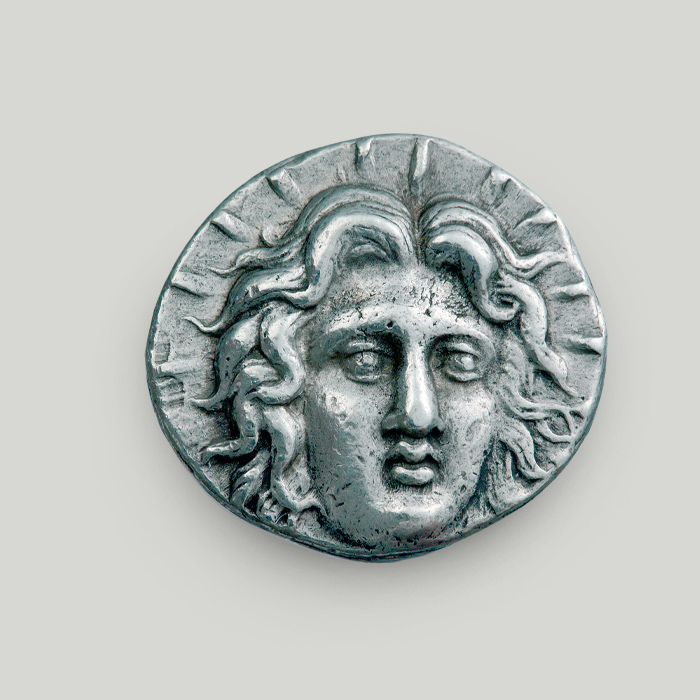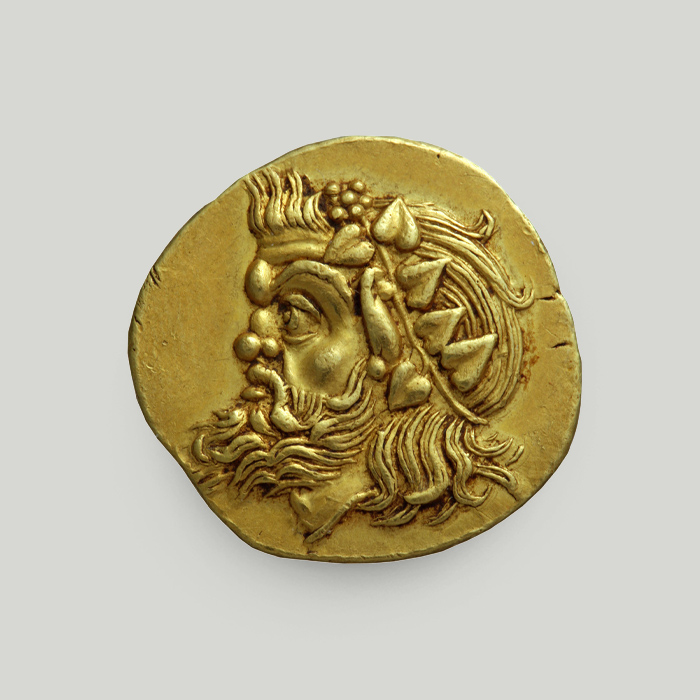Silver tetradrachm of Demetrius Poliorcetes
The coins issued by Demetrius Poliorcetes (the Besieger) are among the most impressive of the Kingdom of Macedon. They are especially valuable due to their innovative traits. The silver tetradrachm of Demetrius Poliorcetes from the Amphipolis mint bears the first depiction of a deified king on Macedonian coinage. The king is depicted with bull horns reminiscent of the god Poseidon, whom he considered his patron and protector.
Obverse
Head of Demetrius with royal diadem and bull horns, within a circular dotted border.
Reverse
The god Poseidon standing, his right foot set on a rock. He holds a trident in his left hand. There are monograms in the field on both sides of the figure. The legend surrounding the type reads ΒΑΣΙΛΕΩΣ ΔΗΜΗΤΡΙΟΥ (of king Demetrius). The type and legend are enclosed in a circular dotted border.
The besieger king of Macedon
Demetrius Poliorcetes was king of Macedon from 294 to 283 BCE. He was perhaps the most prominent among the Diadochi, the successors of Alexander the Great.
Demetrius was born to Antigonus I Monophthalmus (the One-eyed) and Stratonice, daughter of the celebrated Macedonian warrior Coragus. His father was his mentor in military techniques, so he participated in battles from a young age.
The first time he served with his father was in the battle of Paraetakene (317 BCE), a region along the frontier between Persia and Media. Weeks after that battle, he was put in command of an elite infantry squad within the Macedonian army in the battle of Gabiene (January 316 BCE). With this battle, Antigonus gained control of the territories between Hindu Kush and the Aegean.
In 306 BCE Demetrius was victorious against Ptolemy’s fleet in Salamis, Cyprus, and managed to conquer the entire island. In 305 BCE he besieged Rhodes but left empty-handed in the end. The ingenuous engines he used during the siege gained him the title “Poliorcetes”, the Besieger.
An effort to re-stablish Alexander’s empire
Despite his dominance at sea, Demetrius was not indifferent to mainland Greece. He returned to reinstate the Corinthian League. However, he had to go back to Asia in assistance of his father, who faced the allied forces of Ptolemy, Lysimachus and Cassander.
Antigonus had proclaimed himself king and intended to re-establish the empire built by Alexander the Great. However, the rest of the Diadochi joined forces against him.
In the battle of Ipsus, Phrygia, in 301 BCE, Antigonus was killed. The great plan to rebuild Alexander’s empire died with him.
Demetrius I Poliorcetes as king of Macedon
After Cassander’s death in 297 BCE, Demetrius managed to ascend the throne of Macedon; he had become king of Macedon by 294 BCE.
He proved to be a powerful, capable and very active general. Back in mainland Greece, he founded the city of Demetrias (present-day Volos) and confronted the combined forces of Lysimachus, Seleucus, Ptolemy and Pyrrhus. In 285 BCE he fell captive to Seleucus, at whose court he died in captivity 2 years later.
After his death, his son Antigonus Gonatas was given his father’s ashes to carry to the latter’s namesake city of Demetrias.
Innovation in the coinage of Demetrius Poliorcetes
The coins issued by Demetrius Poliorcetes (the Besieger) are among the most impressive of the Kingdom of Macedon. They are also especially valuable thanks to their innovative traits.
Demetrius used types that were unrelated to the past of the Kingdom of Macedon. The new types mainly included depictions of:
- The god Poseidon, Demetrius’ patron and protector.
- The goddess Nike (Victory) on a ship’s prow to commemorate his naval victories, predominantly the one over Ptolemy in Salamis, Cyprus.
The silver tetradrachm of Demetrius Poliorcetes from the Amphipolis mint bears the first depiction of a king presented as a god on Macedonian coinage.
Poseidon as patron and protector
Demetrius Poliorcetes honoured the god Poseidon with his coinage. His naval victories had led him to believe that Poseidon protected him.
In fact, the obverse of the silver tetradrachm depicts Demetrius deified, with bull horns on his head to bring to mind one of the god’s sacred animals.
Fractions and etymology
As suggested by its name, the tetradrachm equalled 4 drachmas. Each drachma equalled 6 obols.
Before the invention of coins, people used iron spits of 1-1.5 meters in length for their daily transactions.
The spits was called ovelos, and 6 of them were considered a standard handful. This handful was later dubbed “drachma”, as it could be grasped (drattomai in Ancient Greek) in a person’s fist.
When coins started to circulate, the word ovelos (the previously used spits) changed to ovolos (“obol” in modern numismatics) and was used to denote the value once held by 1 spits, i.e. 1/6 of a drachma.
The coin in our publications
The silver tetradrachm of Demetrius Poliorcetes is mentioned in the book Coins of Macedonia in the Alpha Bank Collection by Dr Dimitra Tsangari. The book discusses coinage in Macedonia. It includes photographs of 171 coins and detailed explanatory texts.
Buy the publication Coins of Macedonia in the Alpha Bank Collection on the Alpha Bank e-shop.
The Alpha Bank Numismatic Collection is not open to the public.
Research visits to the Numismatic Collection can be organised upon request.
Contact us to book your visit.








